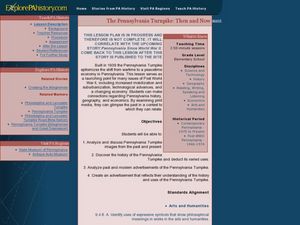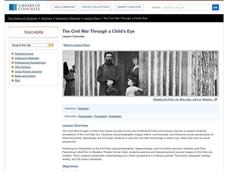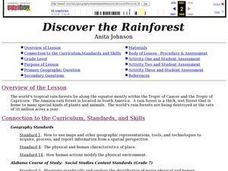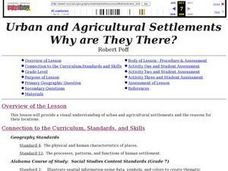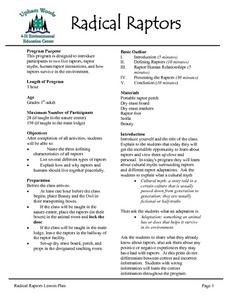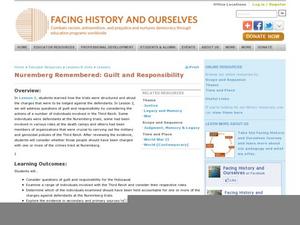Curated OER
"Disapproved": Censorship of Film in Pennsylvania
Students analyze primary source documents of the 1920s to find the roots of film censorship and understand Pennsylvania's leadership in this movement. They analyze government censorship documents that banned a film in Pennsylvania and...
Curated OER
The Secret is Out
High schoolers research history of biomedical research and development of ethics in clinical trials, define informed consent, describe primary components of informed consent decision, and discuss government's role in protecting rights of...
Curated OER
The Pennsylvania Turnpike: Then and Now
Students study the history of the Pennsylvania Turnpike. For this Pennsylvania history lesson plan, students use primary documents to study the history of the Pennsylvania Turnpike. In a culminating activity, students create an...
Curated OER
The Decisive Victory: Philadelphia and the Winning of the War for American Independence
High schoolers examine primary documents and apply their knowledge to describe them. For this primary document analysis lesson pupils interpret sources and evaluate roles of foreign allies.
Curated OER
The Civil War Through a Child's Eye
Students use primary and secondary sources to observe a child's view of the Civil war. In this Civil War lesson, students understand that different people had different perspectives on the war. Students recognize the...
Curated OER
Clue In On Color
High schoolers consider the effects of color on moods and feelings. They participate in a variety of demonstrations to explore the role of illusion and suggestion in human perception. They consider which color best represents their...
Curated OER
Discover the Rain Forest
Middle schoolers research tropical rain forests through the use of trade books, encyclopedias, rain forest videos, and computer searches to determine the effects that human use has on the rain forest.
Curated OER
Body Parts Vocabulary
Students identify the main parts of the human body. In this human body vocabulary lesson, students trace each other's body outline on butcher paper and label the parts of the body. Students define what each body part does. This lesson is...
Curated OER
Fighting Disease
Seventh graders explore the concept of medical intervention in African nations. In this geography lesson, 7th graders research primary and secondary sources in search of information regarding Guinea worm disease. Students use their...
Curated OER
Urban and Agricultural Settlements Why are They There?
Seventh graders identify types of human settlements, urban and agricultural, and determine geographic influence on why people settle where they did by use of maps and charts. They, in groups, identify the needs of a new settlement, which...
Curated OER
Critical Reading, Imaginative Writing and the Montage
Students discuss the difference between primary and secondary sources and consider how an exhibit is researched. They design and create a montage that reflects themselves in a social and historical context.
Curated OER
Acid Rain
Students use real-time weather maps to determine the likelihood of acid rainfall in a region. Students apply their understanding of interaction between weather systems, land and air pollution, to address acid rain and the effects on...
Curated OER
Radical Raptors
Students are introduced to raptors and their role in the environment. They identify three characteristics of raptors and list several types of raptors found in nature. They discuss their positive and negative experiences with raptors and...
Curated OER
Reproduction and Development
In this human reproduction worksheet, students will review the male and female anatomy and the hormones involved in the development towards sexual maturity. Students will also review the events that occur during the three phases of the...
Curated OER
The Aerial Age
Young scholars infer America's attitude towards aviation in the early 1900s. In this The Aerial Age instructional activity, students analyze early 1900s literature, music, advertisements, and popular culture in reference to aviation....
Curated OER
The Roanoke Mystery
Fourth graders hypothesize about what happened on the island of Roanoke. In this South Carolina history lesson, 4th graders use primary documents to draw conclusions about what happened to the Lost Colony of Roanoke. This mini-unit...
Curated OER
Biochemical Cycles: Recycling Carbon and Nitrogen
Students construct flow diagrams of the carbon and nitrogen cycle processes. They identify sequences in each cycle that are affected by human impact and present their research to the class.
Curated OER
Discovering the Local Community
Third graders create a mini-atlas of the human and physical characteristics of their local community, which includes landforms, climate, vegetation, population, and economics. They use nonfiction map-related resources to obtain ...
Curated OER
The Cause and Course of the Great War
Students interpret historical evidence presented in primary and secondary resources. In this World War I lesson plan, students research the causes of the war as well as the major events of the war. Students are...
Curated OER
Nuremberg Remembered: Guilt and Responsibility
Students explore the Nuremberg trials. For this Holocaust lesson, students research the Nuremberg trials. They gather primary sources or documents to support their arguments for the charges against people examined in the trials.
Curated OER
Strengthening Democracy In Latin America
Students consider how to strengthen democratic principles in Latin America. In this government systems lesson, students explore the challenges to democratic forms of government in Latin America as they examine primary sources. Students...
Curated OER
Volcanoes And Atmospheres
Students identify the volcano as the primary source of atmospheric gases, to explain the formation of ozone, and to recognize the dangers of volcanic gases through the use of technology in the classroom.
Curated OER
Push and Pull Factors on Migration
Students investigate push and pull factors. In this population trends lesson, students examine primary sources that help them comprehend how push and pull factors have changed over time.
Curated OER
Stimulus Response
Pupils explore the five steps in the stimulus-response pathway. They analyze the senses and the difference between animals' primary and secondary senses. Students collect information about animal behavior to debate the ethics of...


